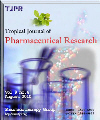
|
Tropical Journal of Pharmaceutical Research
Pharmacotherapy Group, Faculty of Pharmacy, University of Benin, Benin City, Nigeria
ISSN: 1596-5996
EISSN: 1596-5996
Vol. 10, No. 3, 2011, pp. 255-263
|
 Bioline Code: pr11034
Bioline Code: pr11034
Full paper language: English
Document type: Research Article
Document available free of charge
|
|
|
Tropical Journal of Pharmaceutical Research, Vol. 10, No. 3, 2011, pp. 255-263
| en |
Therapeutic Efficacy Evaluation of Metronidazole and Some Antifungal Agents with Meglumine Antimoniate on Visceral Leishmaniasis by Real-Time Light-Cycler (LC) PCR in BALB/c Mice
Bahashwan, Saleh A
Abstract
Purpose:
To develop a highly accurate molecular assay for evaluating the efficacy of metronidazole and some antifungal agents with meglumine antimoniate against L. infantum visceral leishmaniasis in different mouse tissues.
Methods:
The assay was performed with the Light-Cycler system using SYBR Green I and primers amplifying ca. 120-bp fragment from minicircles of the kinetoplast DNA (kDNA).The mice were divided into two groups. Group I served to evaluate drug activity and parasite load while Group II was assigned to identify possible synergistic activity between meglumine (which is highly effective in the liver but less effective in the spleen) and drugs with significant activity against spleen infection.
Results:
The assay was able to detect as little as 100 fragments of L. major DNA per reaction, which is equivalent to 0.1 parasites. The standard curve designed for quantitation of parasites showed linearity over at least 6-log DNA concentration range, corresponding to 0.1 to 104 parasites per reaction with a correlation coefficient of 0.979. Metronidazole, ketoconazole, fluconazole, itraconazole and terbinafine were less effective than antimonial agents in reducing hepatic parasite load while ketoconazole potentiated the effect of meglumine antimoniate reference therapy through its marked activity against spleen infection (L. infantum visceral leishmaniasis).
Conclusion:
The assay technique is accurate, sensitive, and rapid for the detection of kDNA and would be of great help to scientists who use animals to monitor the efficacy of anti-leishmanial drugs or vaccines.
Keywords
Leishmaniasis, Molecular diagnosis, Kinetoplast DNA, Real-Time LightCycler(LC)-PCR, Spleen infection, Antifungal agents
|
| |
© Copyright 2011 Tropical Journal of Pharmaceutical Research.
Alternative site location: http://www.tjpr.org
|
|
